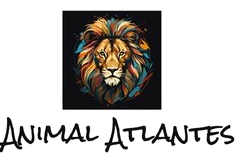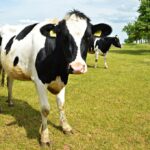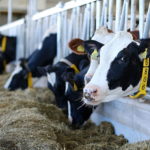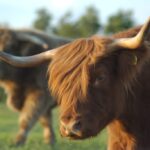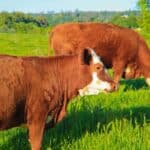Cows are sensitive creatures that have well-defined habitat requirements. Let’s learn more about it.
Cows prefer living in large, open areas where there is a water source nearby and the temperature remains moderate. They live in the grasslands, forests, and pastures of different regions across the globe, including South Asia, Africa, the United States, Europe, New Zealand, Canada, and Australia, among others.
There are a lot of questions that are frequently asked about the cow’s habitat. Let’s answer some of them.
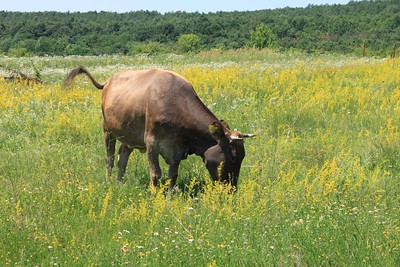
Image Credits: “Single-cows-grazing-in-a-field_grass-and-flowers__4738IMG_0818” by Public Domain Photos is licensed under CC BY 2.0
What is a cow’s habitat?
While it is a well-established fact that cows are pretty adaptable, they still prefer living in their natural habitat. So, what constitutes a cow’s habitat? Let’s find out.
The primary habitat of cows refers to their natural environment and usually includes open areas and pastures. They prefer living in grasslands but can also adapt to different habitats, as long as there is sufficient vegetation. Some cow habitats include desert edges, savannas, valleys, and scrub forests.
Being in open areas is quite freeing for the cows who move around looking for food and water. It enables them to thrive and improves their overall mood.
Where do cows mainly live?
Cows are intriguing animals that have specific habitat and nutritional requirements. Let’s find out where cows live.
Cows prefer living in open areas and pastures. This is because they need sufficient land for grazing throughout the day. Some farmers that are rearing beef and dairy cows put them in barnyards. Usually, cows are pretty adaptable as long as they’re in a herd and have plenty of space to move around.
Cows are surprisingly not at all picky when it comes to their environment. However, they do need to be in a place with sufficient vegetation to derive their daily feed.
What is a cow house called?
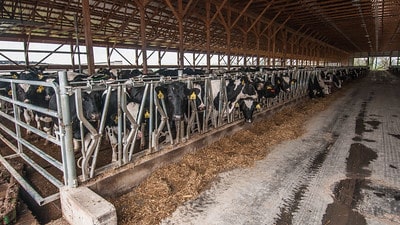
Image Credits: “20110419-RD-LSC-0781” by USDAgov is marked with CC PDM 1.0
The houses of animals are given very specific and interesting names. Let’s see what a cow house is called.
A cow’s house has different names such as byre, barn, barn house, cowbarn, or simply cowshed. Most people refer to cow houses as cowsheds, just like the house of dogs is called kennel, that of sheep is called a pen, and those of horses is called stable. Barns also hold grains and hay that are used for feeding cows.
It is worth mentioning here that cattle, particularly beef cattle, also live on a ranch, an area of land specifically dedicated to raising livestock such as sheep and cattle.
What impact does habitat have on the cow?
Cows are sensitive and intelligent creatures. Naturally, their living conditions are going to impact them significantly. Let’s find out how.
The habitat of a cow greatly affects its productivity and mood. For instance, cows prefer open spaces with a water source nearby, and its absence may make them cranky and affect their overall productivity. That being said, domestic cows usually adapt to their surroundings and seldom complain, as long as they’re fed well.
It is worth mentioning here that farmers are looking at alternative habitats for cows that closely imitate their natural habitat since unchecked grazing of livestock has a negative impact on the environment and forest cover.
Do cows live in hilly regions?
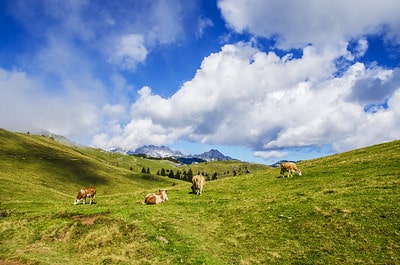
Image Credits: “Cows Grazing in a Pasture” by Image Catalog is marked with CC0 1.0
As we have mentioned before, cows prefer living in open areas. But does that include hilly regions as well?. Let’s find out.
Most cows do not live in hilly regions, but some breeds can easily climb the mountains and hills. Since cattle primarily graze on flat land or creeks, it results in overgrazing in these regions. However, the hillsides have quality forage that is often neglected, and this is where hill-climbing cattle prove to be useful.
Grazing cattle also need a water source nearby, and therefore, they do not live in hilly regions for long as it often lacks a proper water source.
Where do cows live in the wild?
While domestic cows occupy barnyards and sheds, wild cows have a different habitat. Allow us to tell you more about it.
Wild or feral cows live in forests in the absence of grasslands. They graze on the forest land and sometimes clear entire forests before moving on to the next one. These feral cows usually move in herds and are very perceptive of their surroundings. They are found in some areas of New Zealand, Ecuador, and the United States.
As a result of overgrazing by wild cows, forest covers have been wiped off, and this poses a threat to the ecological balance.
Where do cows live in the winter?
Cows have a pretty thick hair coat which makes them resistant to cold weather. Let’s check out where cows live in winter.
Cows prefer living in dry barns during the cold weather. As long as the area has sufficient space to move around and lie down, cows do not mind the cold. This is because they are warm-blooded animals. So, an unheated barn will be a great place for them since their body generates enough heat to make it comfortable.
The thick coat of cows is a massive advantage during the cold weather. If given an uninterrupted supply of food and water, cows can easily thrive during the colder months.
Where do cows live in the summer?
Excessive heat is said to be a threat to cows since they’re warm-blooded animals. Let’s find out where they live in the summer.
Cows graze outside during the summer months. Although they do not sweat a lot, they cool themselves down by radiating heat from their bodies and breathing a lot. However, they also reduce their feed intake, due to which there is a drop in their energy levels, and consequently, it impacts their reproductivity.
There is a considerable decrease in the productive capacity of cows during the summer months, and farmers look for different ways to help cows deal with extreme heat stress.
Where do cows live in Australia?
Australia houses around 25 million cattle in various regions. Let’s find out where cows live in Australia.
Cows, particularly dairy cows, occupy the southeast corner of Australia since the region is suitable for dairying and has sufficient pasture land. That being said, cows are also found in areas such as Queensland, which is called the beef-powerhouse of the country. You’ll also find cows in New South Wales.
Australia abounds in both dairy cows and beef cattle. There is a lot of demand for beef and cow milk throughout the country, and therefore, farmers get sufficient incentive to rear cattle.
Where do Highland cows live?
Highland cows are a Scottish cattle breed, and the term ‘highland’ may tell you something about where they live. Let’s find out more.
Highland cows are rustic breeds that live in different regions. These include:
- The Isle of Skye.
- Scottish Highland.
- The Scottish Islands.
- The Isle of Mull.
- Loch Ness.
- Plockton.
- Applecross.
- North America.
- Australia.
- Europe.
Highland cows are easy to maintain, as they’re not very picky when it comes to feed and shelter choices. As such, they are reared in different regions across the globe, including the Scandinavian countries and Alaska.
Where do fluffy cows live?
Fluffy cows are characterized by their thick coats, which provide them with tremendous warmth. Let’s find out where they live.
Fluffy cows live in highlands and cooler regions, where there is sufficient vegetation cover for grazing and enough water supply. You will often spot them in Scotland, especially in the southern part. These days, fluffy cows are also found in other regions such as North and South America, Australia, Canada, and Europe.
Fluffy cows are pretty rare, and therefore it is essential to rear them with care and sensitivity. The farmers go out of their way to provide them with the right environmental conditions to grow and thrive.
FAQs
Q: Where do cows live?
A: Cows live in various types of habitats such as grasslands, pastures, and farms.
Q: What is a cow’s habitat?
A: A cow’s habitat typically consists of areas with abundant grass and vegetation for them to graze on.
Q: What is the role of grass in a cow’s habitat?
A: Grass is an essential part of a cow’s habitat as it is their primary source of food.
Q: Are cows domesticated?
A: Yes, cows are domesticated animals that have been bred and raised by humans for various purposes.
Q: What is the difference between dairy cattle and beef cattle?
A: Dairy cattle are specifically bred for milk production, while beef cattle are bred for meat production.
Q: How do cows protect themselves from predators?
A: Cows rely on their herd for protection from predators, and they also have a strong sense of smell and hearing to detect potential threats.
Q: What are some common cattle breeds?
A: Some common cattle breeds include Holstein, Hereford, Angus, and Highland.
Q: What do cows typically eat?
A: Cows typically eat grass and other vegetation found in their habitat.
Q: How do cows provide milk?
A: Female cows, known as heifers or cows, produce milk to feed their calves. Dairy farmers milk the cows to obtain milk for various dairy products.
Q: Do cows live in herds?
A: Yes, cows are social animals and often live in herds with other cows.
Q: What is a cow?
A: A cow is a domesticated bovine animal that is commonly raised for meat production and dairy farming.
Q: What do cows eat?
A: Cows primarily eat grass and other vegetation found in pastures.
Q: How do cows spend their time?
A: Cows typically spend their time grazing on grass and resting in the shade.
Q: How do cows protect themselves from predators?
A: Cows rely on their herd for protection from predators.
Q: What are the different breeds of cattle?
A: There are various breeds of cattle, such as Hereford, Highland, Chianina, and Texas Longhorn.
Q: Can cows be used as draft animals?
A: Yes, cows can be trained to be used as draft animals.
Q: What is the difference between dairy cattle and beef cattle?
A: Dairy cattle are primarily bred to produce milk, while beef cattle are raised for meat production.
Q: How are cows bred?
A: Cows are bred either naturally through mating or through artificial insemination.
Q: Do bulls differ in size compared to cows?
A: Yes, bulls are generally larger than cows.
Q: Where do cows typically live?
A: Cows can be found on farms and ranches, where they are raised for various purposes.
Conclusion
Cows are adaptable and docile animals but can get quite cranky and aggressive if they feel threatened or mistreated. Therefore, it is essential to provide them with a peaceful environment to grow and flourish.
If cows have a suitable living environment, their productivity increases, and they can produce more milk and deliver healthier calves. Remember, open spaces with water sources and green pastures are a cow’s best friend.
